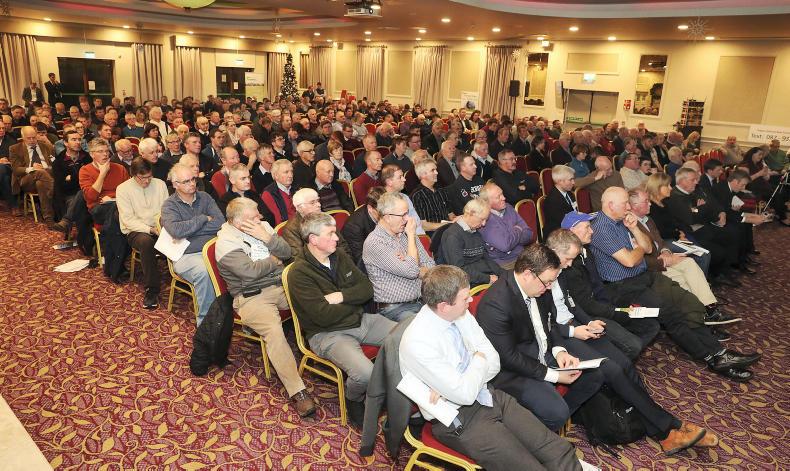Meat eating quality could become more and more important in the future in terms of Irish beef’s unique selling point.
That was the message from Donagh Berry at Tuesday’s Teagasc beef conference in Mayo. He said: “Other countries have caught up very fast with traceability and tagging so we need to move on to the next level. We believe that one of these avenues could be meat eating quality.

Donagh Berry presented new research on meat eating quality of 5,500 animals of a range of breed types.
“For the last few decades, farmers have selected on quantity rather than quality when it comes to bull selection, heavier carcase weights, better conformation while meat eating quality hasn’t been to the fore in the decision making process.”
Teagasc and ICBF assessed 5,500 animals for meat tenderness, flavour and juiciness using a trained tasting panel.
The Angus and Hereford sires came out on top in the test, with Simmental sires coming out lowest for meat-eating quality.
The next step is to include meat-eating quality in genetic indices and hopefully in the future the market would pay more for animals sired by bulls with high meat eating quality traits.
“I am convinced that after three years of debate and negotiations, Brexit won’t happen. Academics, economists, industry, the Bank of England have all said it doesn’t make sense. I don’t think it will happen.”
– Senator Ian Marshall
“Looking at emissions from livestock, our high replacement index females are producing 20% less methane. This is hugely positive for the suckler herd going forward. We have the potential to breed a low carbon suckler cow.”
– Andrew Cromie, ICBF
“Irish beef exports will fall by 11% in 2019 but overall UK beef imports are down 13% due to weaker demand, which means that our share of the UK market has grown by 4% to 80% in 2019. Across Europe, consumption of beef is likely to fall by 1% in 2019.”
– Joe Burke, Bord Bia
“The beef sector will have to make a contribution to climate change like every other sector.”
– Dale Crammond, Climate Change Division, Department of Agriculture
“I think in 10 years’ time we will probably see fewer suckler farmers and fewer suckler cows, somewhere in the region of 700,000.”
– Kevin Hanrahan, Teagasc
Meat eating quality could become more and more important in the future in terms of Irish beef’s unique selling point.
That was the message from Donagh Berry at Tuesday’s Teagasc beef conference in Mayo. He said: “Other countries have caught up very fast with traceability and tagging so we need to move on to the next level. We believe that one of these avenues could be meat eating quality.

Donagh Berry presented new research on meat eating quality of 5,500 animals of a range of breed types.
“For the last few decades, farmers have selected on quantity rather than quality when it comes to bull selection, heavier carcase weights, better conformation while meat eating quality hasn’t been to the fore in the decision making process.”
Teagasc and ICBF assessed 5,500 animals for meat tenderness, flavour and juiciness using a trained tasting panel.
The Angus and Hereford sires came out on top in the test, with Simmental sires coming out lowest for meat-eating quality.
The next step is to include meat-eating quality in genetic indices and hopefully in the future the market would pay more for animals sired by bulls with high meat eating quality traits.
“I am convinced that after three years of debate and negotiations, Brexit won’t happen. Academics, economists, industry, the Bank of England have all said it doesn’t make sense. I don’t think it will happen.”
– Senator Ian Marshall
“Looking at emissions from livestock, our high replacement index females are producing 20% less methane. This is hugely positive for the suckler herd going forward. We have the potential to breed a low carbon suckler cow.”
– Andrew Cromie, ICBF
“Irish beef exports will fall by 11% in 2019 but overall UK beef imports are down 13% due to weaker demand, which means that our share of the UK market has grown by 4% to 80% in 2019. Across Europe, consumption of beef is likely to fall by 1% in 2019.”
– Joe Burke, Bord Bia
“The beef sector will have to make a contribution to climate change like every other sector.”
– Dale Crammond, Climate Change Division, Department of Agriculture
“I think in 10 years’ time we will probably see fewer suckler farmers and fewer suckler cows, somewhere in the region of 700,000.”
– Kevin Hanrahan, Teagasc







 This is a subscriber-only article
This is a subscriber-only article










SHARING OPTIONS: